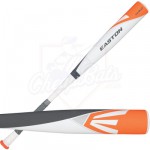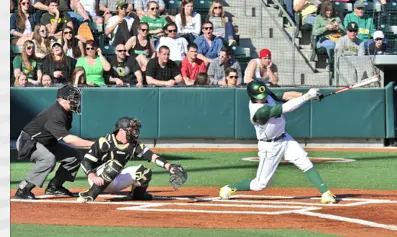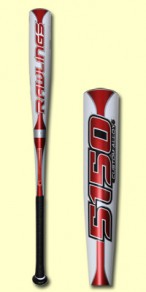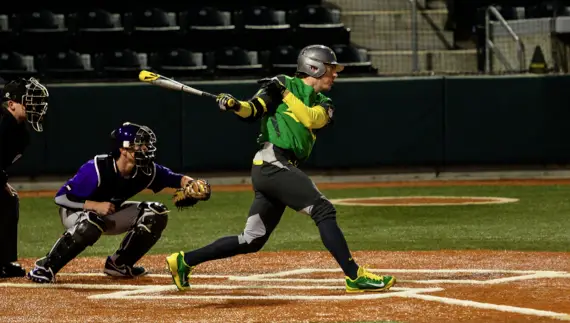An aspect of a baseball game that we give very little thought to are the bats used. Bats are a very personal issue with ball players — and at the professional level it is almost a ‘reverent sacrilege’ to fool with another player’s bat. Furthermore, let the equipment manager put a regular player’s bat in a different position in the rack and the dugout will become a scene of chaos.
The same is true on the collegiate level – get to PK Park early and watch the players take batting practice. When a Duck player comes to the batting cage to take his swings, you will see as many as three bats in his hands, while his ball glove is just hanging somewhere in the dugout. Player’s bats are a sacred focus for those who are serious about their performance, and as fans, we tend to overlook the carefully selected bat in his hand.

A $300 bat!
Our Ducks, settling on what feels good, have selected their bats – some, maybe junior outfielder Kyle Garlick, will swing a small-handled “fat” barrel model ( 2.75″), having that heavier, power feel. Another, maybe freshman shortstop Kevin Minjares, a slightly “fatter” handle and a 2.5″standard barrel, which gives a lighter, quicker bat control perception.
Generally speaking, the big guys like the heavier models as they provide more power, while those players of smaller stature generally carry lighter-feeling bats to the plate.
Although players at the college level also will generally swing a 33- or 34-inch bat, of actual importance is a bat’s Drop-Rating. The Drop-Rating is the length of the bat minus its weight, and an example of this measurement could be a 34-inch bat with a 31-ounce weight giving the bat a Drop-Rating of -3 or a 34-inch bat with a 22-ounce weight thus a Drop-Rating of -12.
The heavier bats, perhaps one used by senior outfielder Tyler Baumgartner (5’11”, 192 lbs.), could have a Drop-Rate of -3 or -4. By contrast, senior outfielder Connor Hoffman (5’10” , 170 lbs.), may swing a 34″-bat with a Drop-Rate of -12, which to the fans at PK Park, would look exactly like the bat brought to the plate by Baumgartner.
In NCAA college baseball and most amateur leagues, players are carrying composite or aluminum alloy-constructed bats. An exception would be an amateur league that has organized to use wooden bats in their play.
The Cape Code League – where Duck 3rd baseman Scott Heineman spent the 2013 summer playing with the Brewster Whitecaps – is known as a Wooden Bat League. The famous and aforementioned Louisville Slugger, constructed of wood taken from the Ash tree, has been a favorite of Major Leaguers for decades.

Scott Heineman
While we are talking about Heineman, you need to know he led his league in stolen bases, while carrying a batting average of .304. That league is noted to have a ton of team talent and play at a quality level greater than most professional rookie leagues.
Heineman’s career as a Duck reflects his talent (recruited as an infielder). He was moved to catcher the fall of 2012 and throughout the preseason of 2013, but he started in center field for the opener in Hawaii — and remained at that position for the entire 2013 Duck and summer league baseball seasons. Not surprisingly, he opened the 2014 season at 3rd base. Scott was obviously a quality recruit, but coaching has made him a more productive team member.

Popular Rawlings Bats
The bats used by the Ducks, and all other NCAA teams, must conform to a rating known as Batted Ball Coefficient of Restitution (BBCOR). That is the measurement of the bat barrel surface recoil after contact with a pitched ball. This is so important that, at the 2013 College World Series, a number of composite bats were disallowed for use in series play because they exceeded the allowable BBCOR.
The NCAA, in their stewardship of the college game, is answering the criticism that metal and composite bats produce a more active response when contacting a baseball, by setting new standards for that response.
The standard is set to mimic the comparable recoil of a wooden bat surface and when you enjoy the play of our Ducks at PK Park, you will notice the metallic “ping” – once heard when metal bats contacted the ball – is gone. As an aside,
The Ducks’ 2013 record of 48 wins and 16 losses – a .666 winning percentage — is that of an elite college program, but still we heard a lot of criticism following post-season play last year – ”The Ducks were all pitching but couldn’t hit.” ”They didn’t get through regional play because they didn’t have the hitting.”
So — is this the season where they put it all together? We will continue to discuss these observations, and others, throughout the season.
Gar Pearson says, “Until next time, Take two and hit deep to right!”
Top Photo by Steve Francis
Related Articles:
Chip Kelly Update: Everything's Good Again ...
Chip Kelly Update: Wailing and Gnashing of Teeth
Shock and Awe -- The Oregon Ducks' Football Hangover Effect
Despite Lopsided Score, Georgia State "Never Stopped Believing"
Hope Springs Eternal for Ducks
Incompetent Pac-12 Officials: How Do You Miss ALL of THIS?
Gar is a businessman, writer, father of 4 very successful children and an enthusiastic life long Duck follower. He remembers being a fair country boy athlete and spent a summer playing baseball in the Dodger organization. Playing is using the term loosely as he remembers primarily being asked to carry the equipment to the bus. He has spent 20 years assisting FEMA in providing Housing for disaster victims.

